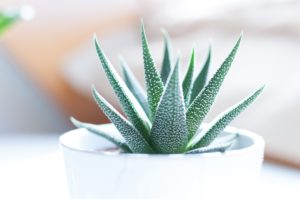When searching for new plants, you likely have a few boxes that need to be ticked off before you decide to bring your new potted pal home. Of course, you want to like the general look and aesthetic of the plant, as it needs to match your design and atmosphere. You also want to make sure it’s the right size for the space you’re looking to fill. And finally, you want it to be low-maintenance. If you’ve already devoted your life to raising kids or pursuing your career, chances are you don’t have the time to constantly tend to your plants, too.
While there are plenty of plants that fit the bill, none top the “easiest” lists that you’ll find online like aloe. Aloe vera is a relatively small plant with thick, fleshy, succulent leaves and vibrant green color. It’s famous for its natural healing abilities and barely-existant maintenance, making it one of the best plants to take home with you.
Aloe Vera Healing Properties
We live in Florida—we’re definitely no stranger to the sun. Anyone who’s ever stepped outside their homes in this sunshine state has likely dealt with a bad sunburn at one time or another. Which means most of us have also probably felt the instant gratification of spreading green, gooey aloe vera gel over our crispy, lobster-red skin. Aloe vera plants have amazing topical abilities, soothing and healing burns, cuts and other small wounds.
Aloe vera is the perfect choice for us heat-worshippers since you can harvest these healing benefits straight from the plant itself! Simply cut one of its succulent leaves off at the base, allow the watery sap to run out, and then rinse the leaf off. Gently remove the skin from the leaf to expose the fleshy, white insides, and rub it onto your burn or wound. It’s even safe to use on your face!

How to Care for Aloe Vera
The best thing about having an aloe vera is the maintenance—or lack thereof. Aloe is the perfect example of a plant that thrives on neglect. It’s true, and a little sad, that the number one way to kill an aloe is to love it too much. Our number one aloe vera care tip is to admire your plant from afar and simply appreciate its independence. Here are a few secondary tips that might help you care for your aloe, too:
Pick the right pot. Many novice plant owners don’t know this, but choosing a container for your plants can be a tricky task sometimes. For plants like succulents and cacti that retain water within their foliage and dislike moist soils, picking the right container can decide the fate of your plant. Pots made of porous materials, like terra cotta, are ideal because they will allow the soil to dry thoroughly. Drainage holes are another necessity, otherwise, water would pool around your aloe’s roots and cause root rot.
Use a well-draining soil. Soils that are specifically for succulents and cacti are ideal have a sandier texture, which provides great drainage. This means water will pass through the soil much easier and quicker, leaving less opportunity for your aloe’s roots to drown.
Place your aloe in bright light. These sun-loving plants fight right in with the Florida population! They love to soak up the UV rays, but keep them sheltered from the especially harsh afternoon sunlight that could burn their leaves.

Water deeply, but infrequently. This one might surprise you, but aloe, along with many plants, would rather deep soaks of water less often than frequent but small bouts of water. This allows the soil to dry completely between waterings, which is exactly what your plant needs. Allow the top two inches of soil to dry before watering your aloe again.
Look for signs of improper watering. Overwatering is definitely a more common problem than underwatering with succulents like aloe. If you notice the leaves of your plant are going limp, you might be showing it a little too much love. If the leaves are looking thin and curled, you might be the rare person who doesn’t water their aloe enough.
Avoid fertilizing your aloe. These plants are pretty good growers all on their own, so they don’t really need that kickstart from fertilizer. In fact, doing so can do more harm than good since fertilizers can easily burn plants—especially those that reside in dry, sunny conditions. If you insist, apply a small dose of all-purpose fertilizer at half-strength just one time in the spring.

How to Divide Aloe Pups
Another great reason to take home one of these fleshy friends is that they multiply! As your aloe plant matures, it’ll start to surround itself with tiny, new plants. These little sprouts, called pups, are just offsets of the main plant, but they can be safely removed once they’re big enough. When they reach about one-fifth of the size of the original plant, you can remove them with sharp cutters and replant them into their own pot! After planting, leave your new plants alone for a couple of weeks and refrain from watering them. It may feel like neglect, but this allows their roots to establish before they’re exposed to moisture.
Aloe vera is the perfect, minimal maintenance plant choice for those who are new to caring for houseplants, who travel often, or who simply want some easy-going greenery in their home. Simply place it in the sunshine, water it when you remember to and enjoy the thick, upright, pointed leaves of this plant and all the fascinating health benefits that come with it!

